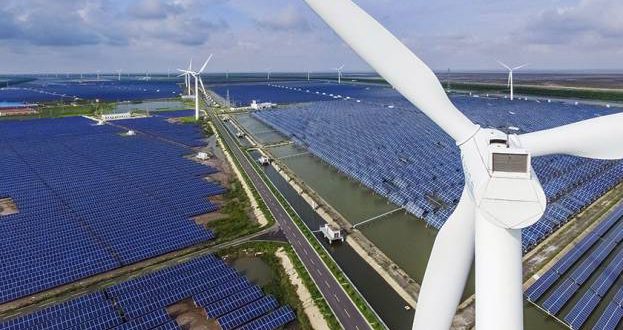Considering his pledges to make the United States “energy dominant.“ President Donald Trump must take satisfaction in Department of Energy (DOE) projections of growing domestic oil production and American influence over crude prices. The U.S. could collectively pump over 10 million barrels of crude a day before the end of 2018 and supersede the Saudis as the world’s second-largest producer. While we can almost certainly expect a Trump tweet if that happens. the Saudis aren’t too concerned about handing over their spot.
Two years on from February 2016’s $35 per barrel price. OPEC’s most powerful producer has instead woken up to the urgency of economic diversification. Just after crude prices hit rock bottom. Saudi Arabia’s King Salman and his son Mohammed bin Salman unveiled their `Vision 2030` for a post-oil economy in the country that usually dictates global oil prices.
To power that future economy (and boost oil exports in the current one). the Saudi government is making substantial investments in renewable energy. Riyadh is planning eight renewables tenders this year. at a total cost of. Most center on solar infrastructure. with Riyadh aiming for 9.5 GW of combined solar and wind capacity by 2023 and 3.3 GW generated by solar this year alone. The Kingdom also wants to award contracts for its first nuclear plant by the end of the year.
At least two of Saudi’s neighbors are taking a similar approach. The United Arab Emirates (UAE) launched its own “Energy Strategy 2050` this month. calling for 44 percent of the UAE’s energy mix to come from renewable sources and 6 percent from nuclear. Prime Minister Sheikh Mohammed bin Rashid al-Maktoum specified the objective was to “balance our economic needs with our environmental goals.“ Energy minister Suhail Mohamed Faraj Al Mazrouei added refresing bluntness: “if (the people) are not happy because of the environment or the cost. then you will have problems.“
Across the Gulf. Iran generated only 200 MW of renewable energy in late 2016 (not including its “mildly“ controversial nuclear facilities) and seeks to expand that to 700MW by March. Tehran shares Emirati and Saudi concerns over clean air and water. the city of Zabol has the most polluted air in the world. Public frustration with pollution and a full-blown water crisis make environmental issues dire policy challenges for the Islamic Republic.
All three countries see renewables as a way to free up more oil and natural gas for export. Saudi Arabia’s domestic energy demand is set to increase threefold by 2030. and much of it is currently met with oil that could otherwise be sold abroad. In 2012. Citigroup warned the Saudis they could become a net oil importerwithin two decades unless they changed course. The Saudi renewable energy initiative is. unsurprisingly. designed to meet a growing share of domestic demand and underpin other Vision 2030 initiatives. like the futuristic “mega-cities` set to run entirely on renewables.
The UAE also has one of the highest per capita rates of electricity consumption in the world. relying on imported LNG to keep up because their own high-sulphur reserves are difficult to process. In Iran. natural gas and petroleum accounted for 98 percent of domestic consumption in 2013. Even if sanctions saw Tehran boost refining capacity to meet domestic needs. years of restricted access to critical technology and investment has left the country’s energy infrastructure in dire need of modernization.
The levels of investment these three countries promise are eye-popping. largely because they have lagged in diversifying beyond hydrocarbons and are playing catch up. GE renewables chief Jerome Pecresse claims it will take $30-40 billion in investment for the Middle East as a whole to meet its 2035 renewable energy targets. That means finding international investors and vendors to help bring each country’s bold pronouncements to fruition.
The three countries may share priorities. but they are competing to attract outside capital to pay for clean energy projects. At the same time. the European. Asian and American companies capable of delivering on these energy targets are jockeying to secure the Gulf’s lucrative tenders.
It may be Europe that ultimately decides the Middle East’s clean energy race. The recent bidding for a 300 MW Saudi solar project. for example. saw a joint Masdar Electricite de France (EDF) bid register what would have been the lowest-ever price per kWh. The Franco-Emirati bid ultimately did not win. but it does show the extent that French and other European companies are willing to go to stake claims in a booming Saudi renewables market. A 400 MW wind farm project tender in Midyan has EDF squaring off with their fellow Frenchmen at Engie but also Acciona. Gestamp. and Cobra from Spain as well Enercon. Siemens. and Nordex from Germany. Final bids are due on March 20.
Saudi Arabia may have some of the most untapped solar potential of any place on Earth. and even if the UAE has a head start. Saudi is being hailed as the most exciting regional player based on sheer volume. Iran can also boast plenty of sun. but many of those same European companies vying to build the Saudi solar plants and wind turbines are more reticent to pursue opportunities there. The Trump administration’s threats to re-impose sanctions have convinced many potential European bidders to steer clear of Iranian projects period.
Despite a few victories — like a $2.9 billion solar plant deal with Norway’s Saga Energy last October — Iran remains highly vulnerable to diplomatic volatility. International investors and vendors could either take a wait-and-see approach with Tehran or skip the wait and look to Saudi and Emirati projects instead. Most of them seem to be opting for the latter.
 Iran Energy News Oil, Gas, Petrochemical and Energy Field Specialized Channel
Iran Energy News Oil, Gas, Petrochemical and Energy Field Specialized Channel




